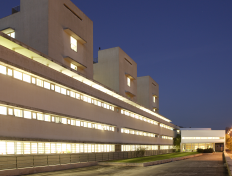Titulo Estágio
A Personal Haptics/Wind Device for VR Environments
Áreas de especialidade
Sistemas de Informação
Sistemas Inteligentes
Local do Estágio
Departamento de Engenharia Informática, Polo II - Pinhal de Marrocos 3030-290 Coimbra
Enquadramento
The immersiveness of a Virtual Reality (VR) experience depends on the number of sense modalities that the system is able to “hijack”. Most VR experiences deal only with the vision and auditory senses, but this is clearly insufficient to provide a realistic environment in many situations. For example, if you think about a VR tour to the top of a lighthouse or tower, the sensation of the wind in your face is important to fully convey the experience of being on top of a tall structure.
Wind sensations have already been created before, e.g. [1-5], however there are no standard or commercial devices that we can use to create our own VR experiences with wind.
This project aims at creating the hardware and software components for such a solution.
Objetivo
Build and program a mobile device for wind sensations on the head of the user that can be coupled with a VR headset (e.g., Oculus Quest 2). The device can be based on, for example, an Arduino or similar microcontroller, and be untethered (communicate with the headset/computer via Bluetooth) or connected directly to the headset (e.g. via USB). The “wind” source and delivery system should be simple, low-cost (on an economical perspective) and energy efficient. A first approach would be to use an array of small fans (such as the ones used in computers and home electronics systems), but the student should also investigate the possibility of using other “unconventional” strategies such as compressed air (either using small air pumps or a hosing system that connects to medium size compressors).
Define how the device will be controlled from the VR environment and develop a library that allows programmers to make use of the device in their VR experiences.
Study the possibility of applying the developed hardware and software (library) to existing VR content through automatic analysis or by developing a system that dynamically acts on the haptic device.
The student should investigate the best solutions for
- quiet, low consumption, small, lightweight “wind” source and delivery system
- communication with the headset/computer
- simple and easy to build microcontroller and necessary electronics
- powering the microcontroller and “wind” system
- how to program the wind sensations in VR
Plano de Trabalhos - Semestre 1
- Research about custom haptic devices for VR
- Research possible hardware to use for the device
- Study the VR headset and possibilities for connecting external hardware to it
- Create a proof-of-concept device
- Write intermediate report
Plano de Trabalhos - Semestre 2
- Develop and refine and device
- Implement a demo VR experience that makes use of it
- Evaluate the resulting experience
- Write dissertation and scientific pape
Condições
Headset VR disponível no departamento
Observações
References
[1] Sherstyuk, A. (2008). Haptic wind. Proceedings of the 2008 International Conference on Advances in Computer Entertainment Technology, ACE 2008, 408. https://doi.org/10.1145/1501750.1501858
[2] Takeda, T., Niijima, A., Mukouchi, T., & Satou, T. (2020). Creating illusion of wind blowing with air vortex-induced apparent tactile motion. Conference on Human Factors in Computing Systems - Proceedings. https://doi.org/10.1145/3334480.3382811
[2] Suzuki, M., & Matsuura, A. (2019). A Wearable VR Device That Provides Temperature-Controlled Wind. In ConVRgence (VRIC) Virtual Reality International Conference Proceedings. Retrieved from https://eds.s.ebscohost.com/abstract?site=eds&scope=site&jrnl=10811451&AN=141285187&h=AweUgzB4lcsNd%2F%2B2WcRQWFSaE4KVyuLB5CEcXE4QdP5xjSAP0KTH4WGszaiW1x%2FlaeUY%2B7YebfkNFlgKimn2nQ%3D%3D&crl=f&resultLocal=ErrCrlNoResults&resultNs=Ehost&crlhashurl=login.aspx%3Fdirect%3Dtrue%26profile%3Dehost%26scope%3Dsite%26authtype%3Dcrawler%26jrnl%3D10811451%26AN%3D141285187
[3] Hsieh, C.-E., Chen, Y.-T., Wang, H.-C., Chen, Y.-S., Han, P.-H., & Hung, Y.-P. (2020). Utilizing handheld wind feedback to expand the perception of environmental wind from stationary device. ACM SIGGRAPH 2020 Posters. https://doi.org/10.1145/3388770
[4] Han, P.-H., Chen, Y.-S., Lee, K.-C., Wang, H.-C., Hsieh, C.-E., Hsiao, J.-C., … Wang, H.-C. (2018). Haptic Around: Multiple Tactile Sensations for Immersive Environment and Interaction in Virtual Reality. Proceedings of the 24th ACM Symposium on Virtual Reality Software and Technology. https://doi.org/10.1145/3281505
[5] Ito, K., Ban, Y., & Warisawa, S. (2020). Manipulating the Perceived Directions of Wind by Visuo-Audio-Haptic Cross-Modal Effects. Lecture Notes in Computer Science (Including Subseries Lecture Notes in Artificial Intelligence and Lecture Notes in Bioinformatics), 12272 LNCS, 235–243. https://doi.org/10.1007/978-3-030-58147-3_26
Orientador
Andre Perrota e Jorge Cardoso
avperrota@dei.uc.pt 📩
